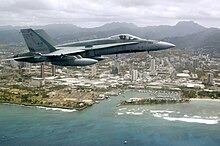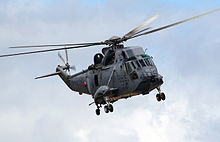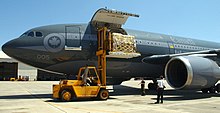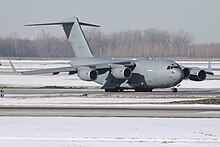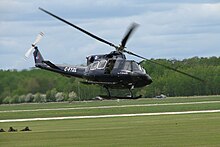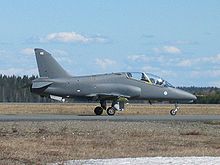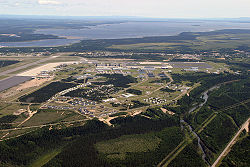Royal Canadian Air Force
The Royal Canadian Air Force (English) or Aviation royale du Canada (French) comprises the air forces of Canada and is part of the Canadian Forces (Canadian Forces / Forces canadiennes). There is also the Canadian Army ( Army ) and the Royal Canadian Navy ( Navy ).
history
The former Royal Canadian Air Force (1924-1968) was combined with the Royal Canadian Navy and the Canadian Army to form the Canadian Forces , which on September 2, 1975 set up Air Command (AIRCOM), which in 2011 was renamed Royal Canadian Air again Force received.
The abolition of the Canadian armed forces initially had the opposite effect for the air force: a large number of scattered air elements . The desired efficiency did not materialize.
AIRCOM, on the other hand, also included the Navy's former Royal Canadian Naval Aviation Service , which reduced the number of air force bases by around 30 percent. In the 1980s, AIRCOM also began to withdraw from European bases, including Baden-Söllingen , Lahr / Black Forest and Northolt . Only the Brize Norton base in England is still used today with the Royal Air Force .
In the 1970s and 1980s, many older types of aircraft were replaced. With the acquisition of the CF-188A / B Hornet , the CF-104 Starfighter and the CF-101 Voodoo (the last fighter aircraft developed in Canada ) were retired. The number of transport helicopters has been significantly reduced. All previous transport helicopters have been replaced by the CF-146 Griffon . Since 2002, all SAR helicopters have also been replaced by the British CH-149 Cormorant . These are supported by the maritime patrol aircraft CP-140 Aurora and CP-142 Arcturus , which were acquired in the late 1970s. The now 40-year-old CH-124 Sea King helicopters, which are used by naval warships, are to be replaced by the CH-148 Cyclone from 2008 .
The international fields of activity of AIRCOM have changed significantly since the 1970s. While the Air Force still played an offensive role on the side of the USA in the Vietnam War , logistics support is the main task of AIRCOM in international missions today. The very experienced helicopter crews in particular have a high international reputation. The importance of the helicopter squadrons in the Canadian Air Force can also be seen in the most recent acquisitions - the US CH-148 Cyclone and the British CF-149 Cormorant - which are among the most modern and powerful helicopters in the world.
In December 2012, the Canadian government announced that the procurement of the Lockheed Martin F-35 fighter jet would be canceled. A replacement model to replace the aging F-18 fleet has not yet been selected.
assignment
The RCAF is the air and space force of the Canadian Forces (CF). Responsibilities include air surveillance and protection of Canadian airspace, aerial search and rescue missions, early detection of ships and aircraft bringing illegal cargo into the country (e.g. narcotics), natural disaster rescue missions, and early detection and protection of the North American Airspace including the USA by the North American Aerospace Defense Command (NORAD). In addition, many other international assignments.
hierarchy
Top hierarchy
The Chief of the Air Staff as the highest member of the Air Force is headquartered in Ottawa in the Department of Defense . It decides the strategy and direction of the air force. The Commander of the 1st Canadian Air Division and Canadian NORAD Region, who has his headquarters in Winnipeg, is responsible for the operational implementation and command of the Air Force activities in Canada and worldwide.
Commander
- Lieutenant-General Bill Carr 1975–1978
- Lieutenant-General George Allan MacKenzie 1978–1980
- Lieutenant-General Kenneth Lewis 1980-1983
- Lieutenant-General Paul David Manson 1983–1985
- Lieutenant-General Donald Malcolm McNaughton 1985–1986
- Lieutenant-General G. Scott Clements 1993-1995
- Lieutenant-General Allan Marvin DeQuetteville 1995–1997
Chiefs of the Air Staff
- Lieutenant-General David Kinsman 1997-2000
- Lieutenant-General Lloyd Campbell 2000-2003
- Lieutenant-General Ken Pennie 2003-2005
- Lieutenant-General Steve Lucas 2005-2007
- Lieutenant-General Angus Watt 2007-2009
- Lieutenant-General André Deschamps 2009–2012
- Lieutenant-General Yvan Blondin 2012–
structure
The Royal Canadian Air Forces are generally organized into four major associations:
-
1 Canadian Air Division ( 1st Canadian Air Force Division ) The 1st Canadian Air Force Division leads the RCAF units. The division commander is also the commander of the Canadian NORAD Region (CANR) - the Canadian area of the joint US-Canadian air defense command . The headquarters of the 1st CAD is located in CFB Winnipeg, Manitoba.
- 1 Wing (CFB Kingston) - This squadron functions as an army aviator and supports the brigade groups of the Canadian Army. The only exception to this is the 427 Special Operations Aviation Squadron , which supports the Canadian special forces and is operationally subordinate to the Canadian Special Forces Command. The headquarters of 1 Wing is located in CFB Kingston Base, there but no aviation associations are stationed. The fifth tactical helicopter squadron, the special-purpose aviation squadron and the tactical helicopter training squadron are in CFB Borden (ON), CFB Edmonton (AB), CFB Petawawa (ON), CFB Valcartier (QC), Montréal (QC) and CFB Gagetown (NB) stationed.
- 3e Escadre (3 Wing) (CFB Bagotville) - This squadron is the French-speaking fighter pilots association of the Royal Canadian Air Force. The squadron also provides air defense patrols in the eastern parts of Canada (such as from CFB Goose Bay, NL). The squadron also reports to a squadron at Gatineau International Airport, QC. She flies with pilots and Dassault / Dornier Alpha Jets from Discovery Air Defense Services - a private company that operates as the EloKa Aggressor unit for the Canadian Armed Forces.
- 4 Wing (CFB Cold Lake) - This squadron is the English-speaking and the slightly larger of the two fighter pilot associations of the Royal Canadian Air Force. The squadron also provides air defense patrols in the western parts of Canada (such as from CFB Comox, BC). The squadron is also responsible for the operational training of fighter pilots and for the international Maple Flag exercises.
- 5 Wing (CFB Goose Bay) - This squadron is just a fighter pilot association without subordinate units to the fighter pilot associations. The squadron's only flying unit is the 444 Combat Support Squadron . This is a helicopter squadron that is responsible for securing the air base and for the SAR operations in the area. CFB Goose Bay is ideal for tactical low-level flight training and for this it accommodates temporary contingents from NATO member countries, including the German Air Force. Goose Bay is also a forward air defense base; Stand-by gangs of CF-18 fighters from the 3 Escadre (CFB Bagotville) are regularly stationed there.
- 8 Wing (CFB Trenton) - This squadron is responsible for air transport duties. The Canadian Boeing C-17A Globemaster and the CC-150 Polaris aircraft are stationed there (among others). A small task force of the Canadian special forces with higher readiness is stationed there next to these strategic air transporters. The squadron also has a squadron for government airlift flights stationed at Ottawa International Airport (ON).
- 9 Wing (CFB Gander) - This is a SAR squadron that flies AgustaWestland CH-149 Cormorant rescue helicopters and is responsible for rescue operations in the eastern parts of Canada and the northwestern Atlantic. Gander Bay is also a forward air defense base; Stand-by gangs of CF-18 fighters from the 3 Escadre (CFB Bagotville) are regularly stationed there.
- 12 Wing (CFB Shearwater) - This squadron is tasked with providing air support to naval forces. It flies the on-board helicopters of the Canadian frigates. In CFB Shearwater (the former base of the aircraft carrier squadrons of the Royal Canadian Navy) there is an emergency and training helicopter squadron. The second helicopter squadron supporting the Pacific Navy Forces is based at Victoria International Airport, British Columbia.
- 14 Wing (CFB Greenwood) - This squadron is responsible for maritime surveillance. It has an operational and training aircraft squadron for this purpose. There is also a transport and rescue team equipped with CC-130 Hercules transport aircraft and CH-149 Cormorant rescue helicopters. In addition to the air transport tasks, the Hercules are used for rescue tasks over the Atlantic, where they look for people in danger and then guide the rescue helicopters to them. Greenwood is also a forward air defense base; Stand-by gangs of CF-18 fighters from the 3 Escadre (CFB Bagotville) are regularly stationed there.
- 17 Wing (CFB Winnipeg) - This squadron includes operational and training units. Winnipeg Airport (MB) has a transport and rescue team and an air navigation training team, as well as six air force schools. A transport and rescue team is stationed at the Yellowknife (NT) airfield. The headquarters of the 1st Canadian Air Force Division is also located there.
- 19 Wing (CFB Comox) - Like the 14 Wing , this squadron is also responsible for maritime surveillance, air transport and rescue. To do this, it has a maritime patrol aircraft squadron and a transport and rescue squadron. Comox is also a forward air defense base; Stand-by squads of CF-18 fighters from the 4th Wing (CFB Cold Lake) are regularly stationed there.
- 22 Wing (CFB North Bay) - This
- 15 Wing (CFB Moose Jaw) - This squadron brings together the flying training units of the RCAF . It is stationed in CFB Moose Jaw, as well as CFB Cold Lake, CFB Winnipeg and Portage la Prairie (MB). The Thunderbirds aerobatic display team is also stationed in CFB Moose Jaw, but reports directly to the 2nd Air Force Division.
- 16 Wing (CFB Borden) - This squadron brings together the training facilities of the RCAF (The RCAF Academy and various schools).
- Canadian Forces Aircrew Selection Center (CFB Trenton) - Canada's
- The RCAF reservists serve in support roles in the squadrons, in the squadrons, as well as in engineer units.
The Royal Canadian Air Force today is the successor to the separate branch of the same name that existed until 1968. But they are an integral part of the unified Canadian Armed Forces . With the unification of three branches of the armed forces, the RCAFs ( Royal Canadian Air Force Station or stations of the Royal Canadian Air Force) became CFBs ( Canadian Forces Base or base of the Canadian Armed Forces). Many units of the three former branches of the armed forces were consolidated and tied in new military objects. Today, the RCAF squadrons are divided into wings (or squadrons). However, these wings are not task forces, but administrative groupings of the RCAF units on the corresponding Canadian armed forces base. These units are operationally managed by the corresponding major association (1st Air Force Division for operational squadrons, 2nd Air Force Division for training facilities and Air Force Reserve for reserve units).
| Royal Canadian Air Force Officer Corps hierarchy | ||||||||||
|---|---|---|---|---|---|---|---|---|---|---|
|
Général Gen service suit |
Lieutenant-General LtGen service shirt |
Major-General MajGen |
Brigadier-General BGen |
Colonel Col |
Lieutenant-Colonel LtCol |
Major Maj |
Captain Cpt |
Lieutenant Lt |
Second Lieutenant SLt |
Officer Candidate Ocdt |
| OF-9 | OF-8 | OF-7 | OF-6 | OF-5 | OF-4 | OF-3 | OF-2 | OF-1b | OF-1a | Student chairman |
 
|
 
|
 
|
 
|

|

|

|

|

|

|

|
| NCOs | ||||||||||
|---|---|---|---|---|---|---|---|---|---|---|
| Chief Warrant Officer CWO |
Master Warrant Officer MWO |
Warrant Officer WO |
Sergeant Sgt |
Master Corporal MCpl |
Corporal Cpl |
Aviator Avr |
Aviator (basic) Avr (b) |
Aviator (recruit) Avr (r) |
||
| OR-9 | OR-8 | OR-7 | OR-6 | OR-5 | OR-4 | OR-3 | OR-2 | OR-1 | ||

|

|

|

|

|

|

|

|

|
||
Remarks
1. The Canadian Forces Chief Warrant Officer is a singular rank and also the highest-ranking NCO in the Canadian armed forces. He is the advocate of the corps of non-commissioned officers.
Aircraft names
In 1947 , what was then the RCAF introduced a new system for marking its aircraft. Until then, the aircraft types, as with the Royal Air Force , were only identified by name. With the new identifier, the names are preceded by a two-digit letter abbreviation with a three-digit number. The letter abbreviation denotes the type of aircraft:
- CF - fighter aircraft
- CP - reconnaissance aircraft
- CC - transport aircraft
- CH - helicopter
- CT - training aircraft
The following three-digit identification numbers are usually assigned consecutively, depending on the year the aircraft type was put into service. There are exceptions to this, however, such as the CF-188 Hornet , which should actually have the identification CF-141 , but whose identification was based on its American designation F-18 .
equipment
Aircraft
| number | Country of Manufacture | image | designation | In use from / since | Remarks |
|---|---|---|---|---|---|
| 72 CF-188A 31 CF-188B |
|
McDonnell Douglas / Boeing CF-18A / B | 1982 | The CF-188 is a modified McDonnell Douglas F / A-18 . Originally 138 of this type were in service, including 98 CF-188A and 40 CF-188B. Since 1984, 15 CF-188A and two CF-188B have crashed. In addition, one CF-188A and seven CF-188Bs were temporarily decommissioned. In the long term, a total of 77 machines are to be kept in operation until 2025. | |
| 29 |
|
Lockheed CC-130 Hercules transport plane | Two versions are currently in operation: 12x CC-130H (replacement by CC-295 from 2020.) and 17x CC-130J | ||
| 5 |
|
CC-150 Polaris / Airbus A-310 | 1997 | Based on the Airbus A-310, but modified as military long-haul cargo versions and two tanker aircraft (CC-150 MRTT). The aircraft were originally delivered to the airline Wardair Canada . | |
| 5 |
|
McDonnell Douglas / Boeing CC-177 Globemaster III | 2008 | Cargo plane | |
| 14th |
|
Lockheed CP-140 Aurora | 1980 | Use for sea reconnaissance Model variants: CP-140 and CP-142. Modified version of the Lockheed P-3 aircraft. In 1998 it was announced that ten machines were to be completely overhauled. This includes the technical, electrical and mechanical systems and runs under the Aurora Incremental Modernization Project (AIMP) project. This work should be completed by the end of 2011. | |
| 4th |
|
Bombardier CC-144 Challenger | 1982 | is used for civil servants and generals. | |
| 6th |
|
de Havilland Canada CC-115 | 1970 | The machines are only used in search and rescue missions. (Replacement by CC-295 from 2020.) | |
| 4th |
|
de Havilland Canada DHC-6 Twin Otter / CC-138 | The machines are used for search and rescue missions. | ||
| 15th |
|
Boeing CH-147 Chinook | 2008 | Six D-versions of the CH-147 were put into service in 2008 and were used in Afghanistan .
15 new CH-147F were delivered from 2013, replacing the older CH-147D. |
|
| 28 |
|
Sikorsky Aircraft / United Aircraft of Canada - CH-124 | 1963 | The helicopters are being decommissioned and gradually replaced by new type CH-148 helicopters . | |
| 17th |
|
Sikorsky CH-148 Cyclone | 2010 | The first helicopters were delivered in February 2010. A total of 28 are to be delivered. The helicopters are based on the civilian model Sikorsky S-92 . The CH-148 Cyclone is a military version. The first flight in the RCAF took place on October 11, 2013. 17 machines had been accepted by February 2019. | |
| 14th |
|
AgustaWestland CH-149 Cormorant / CH-149 | 2000 | The helicopters are used for search and rescue missions. | |
| 83 |
|
Bell helicopter / Bell CH-146 Griffon | 1995 | Multipurpose helicopter. | |
| 21st |
|
British Aerospace / CT-155 Hawk | 2000 | Training and training aircraft. |
Other aircraft for education and training purposes:
- 22 CL-114 "Tutor" training aircraft (these are also used by the CFAC aerobatic team , the Snowbirds )
- 24 CT-156 “Harvard II” training aircraft
- 4 CT-142 "Gonzo" training aircraft
- 4 CT-133 “Silver Star” training aircraft
For former aircraft, see the list of RCAF / AIRCOM aircraft
Weapon systems
| Manufacturer | Country of Manufacture | weapon | Type | In use since | Remarks |
|---|---|---|---|---|---|
| Lockheed Martin |
|
GBU-10 Paveway II | laser-guided aerial bomb | 1980 | used by CF-18 combat aircraft |
| General Dynamics |
|
Mark 82 | unguided multipurpose free-fall bomb | 1990 | used by CF-18 fighter aircraft |
| General Dynamics |
|
Mark 83 | based on Mark 82, but larger | 1980 | used by CF-18 |
| General Dynamics |
|
Mark 84 | based on Mark 82, greater than 83 | 1980 | used by CF-18 |
| Raytheon / Hughes Aircraft |
|
AGM-65G | Air-to-surface missile | 1980 | used by CF-18 |
| Bristol Aerospace |
|
CRV 7 | Air-to-surface missile | 1980 | used by CF-18 |
| Douglas Aircraft Company |
|
AIM-7 Sparrow | Air-to-air missile | 1980 | used by CF-18 |
| Raytheon / Hughes Aircraft |
|
AIM-120 AMRAAM | Air-to-air missile | 2000 | used by CF-18 |
| Boeing |
|
Joint Direct Attack Ammunition | Joint Direct Attack Ammunition | 2011 | used by CF-18 |
| Raytheon / Ford Aerospace / Loral Corp. |
|
AIM-9 Sidewinder | Air-to-air missile | 1980 | used by CF-18 |
| General Dynamics / General Electric |
|
M61 Vulcan | 20 mm automatic cannon | 1980 | used by CF-18 |
| Alliant Tech Systems |
|
Mark 46 torpedo | Underwater torpedo for submarine hunting | 1980 | used by CP-140 Aurora and CH-124 helicopters. |
| FN Herstal |
|
FN MAG C6 | 7.62mm machine gun | 1980 | used by CP-140 and CH-124 helicopters. |
Unmanned aerial vehicles / drones
The Air Force has unmanned aerial vehicles of the following types:
- Maveric UAS - miniature reconnaissance drones
- Boeing ScanEagle - miniature reconnaissance drones
- IAI Heron - reconnaissance drones
- ALIX / BAE Systems - SilverFox miniature reconnaissance drones
- MMIST - MMIST CQ-10, unmanned transport drones
bases
Canada
There are the following military airfields . They are usually home to a wing to which all other units are subordinate.
- CFB Bagotville , Québec , 3rd Wing, eastern fighter base
- CFB Borden , Ontario , 16th Wing, main training center and "birthplace" of Canadian military aviation
- CFB Cold Lake , Alberta , 4th Wing, western and main fighter base
- CFB Comox , British Columbia , 19th Wing, western base for maritime patrols and SAR helicopters
- CFB Gander , Newfoundland , 9th Wing, eastern base for SAR helicopters
- CFB Goose Bay , Newfoundland , 5th Wing, without its own airborne units
- CFB Greenwood , Nova Scotia , 14th Wing, Eastern Maritime Reconnaissance Base
- CFB Kingston , Ont . 1st Wing, Transport Helicopter Base
- CFB Moose Jaw , Saskatchewan , 15th Wing, Second Training Center
- CFB Trenton , Ontario , 8th Wing, the main air transport base
- CFB North Bay , Ontario , 22nd Wing, without its own flying elements. Headquarters of the North American Aerospace Defense Command (NORAD).
- CFB Shearwater , Nova Scotia , 12th Wing, Airborne Helicopter and Search and Rescue Helicopter Land Base
- CFB Winnipeg , Manitoba , 1st Canadian Air Divisions Headquarters and 17th Wing, home to SAR and training aircraft
- CFB Alert , Nunavut , 8th Wing, Trenton, is the northernmost base in Canada and worldwide.
The RCAF can also rely on four non-permanent forward operating bases in the north, in Inuvik and Yellowknife , both Northwest Territories , and Iqaluit and Rankin Inlet , both Nunavut; all are mainly civilian airports.
Bases abroad
The RCAF uses Allied Forces bases for its international operations. Including bases of the Americans, British and other allies. In Germany, the RCAF has set up a transshipment point in Spangdahlem on the US Spangdahlem Air Base in order to be able to support the Canadian soldiers in Afghanistan materially and personally. In addition, Canadian soldiers are stationed at the NATO Air Base in Geilenkirchen .
See also
Web links
- Official website of the Royal Canadian Air Force
- Official website of the Aviation Royale Canadienne (French)
Individual evidence
- ↑ Canadian Air Force Leadership and Command (PDF; 1.85 MB) Defense Technical Information Center. November 2006. Retrieved April 9, 2012.
- ↑ Peter MacKay says 'royal' renaming of military . CBC / Radio Canada . August 16, 2011. Retrieved April 9, 2012.
- ↑ Canada cancels F-35: super fighter jet in turbulence. In: DiePresse.com. December 14, 2012, accessed January 7, 2018 .
- ↑ Thirty Years of Air Command: LGen Bill Carr Recalls AF Re-birth . Archived from the original on December 6, 2007. Info: The archive link was automatically inserted and not yet checked. Please check the original and archive link according to the instructions and then remove this notice. Retrieved July 9, 2009.
- ^ Canadian Who's Who 1997 . Retrieved July 9, 2009.
- ^ A Long Forgotten Piece of History . Archived from the original on July 23, 2012. Info: The archive link was automatically inserted and not yet checked. Please check the original and archive link according to the instructions and then remove this notice. Retrieved April 3, 2010.
- ^ Advisory Council . Archived from the original on July 8, 2009. Info: The archive link was automatically inserted and has not yet been checked. Please check the original and archive link according to the instructions and then remove this notice. Retrieved July 9, 2009.
- ^ Canadian Who's Who 1997 . Retrieved July 9, 2009.
- ^ Canadian Who's Who 1997 . Retrieved on July 9, 2009. ( Page no longer available , search in web archives ) Info: The link was automatically marked as defective. Please check the link according to the instructions and then remove this notice.
- ^ Canadian Who's Who 1997 . Retrieved July 9, 2009.
- ↑ http://www.rcaf-arc.forces.gc.ca/en/1-cdn-air-div/index.page
- ↑ http://www.rcaf-arc.forces.gc.ca/en/2-cdn-air-div/index.page
- ↑ http://www.rcaf-arc.forces.gc.ca/en/cf-aerospace-warfare-centre/index.page
- ↑ http://www.rcaf-arc.forces.gc.ca/en/air-reserve/index.page
- ↑ a b CC-295. Government of Canada, July 11, 2019, accessed October 10, 2019 .
- ↑ Medium-to-Heavy Lift Helicopter Project: Status . Retrieved January 10, 2017
- ↑ RCAF Newsroom , accessed August 25, 2014
- ↑ CH-148 Cyclone procurement project. Government of Canada, July 16, 2018, accessed August 3, 2019 .
- ↑ National Defense and the Canadian Forces - CF-188 Hornets on Op MOBILE drop first JDAM bombs ( Memento of the original from March 8, 2012 in the Internet Archive ) Info: The archive link was inserted automatically and has not yet been checked. Please check the original and archive link according to the instructions and then remove this notice. . Retrieved July 3, 2012
- ^ Royal Canadian Air Force. (No longer available online.) Department of National Defense , archived from the original on June 21, 2013 ; accessed on May 15, 2013 . Info: The archive link was inserted automatically and has not yet been checked. Please check the original and archive link according to the instructions and then remove this notice.




